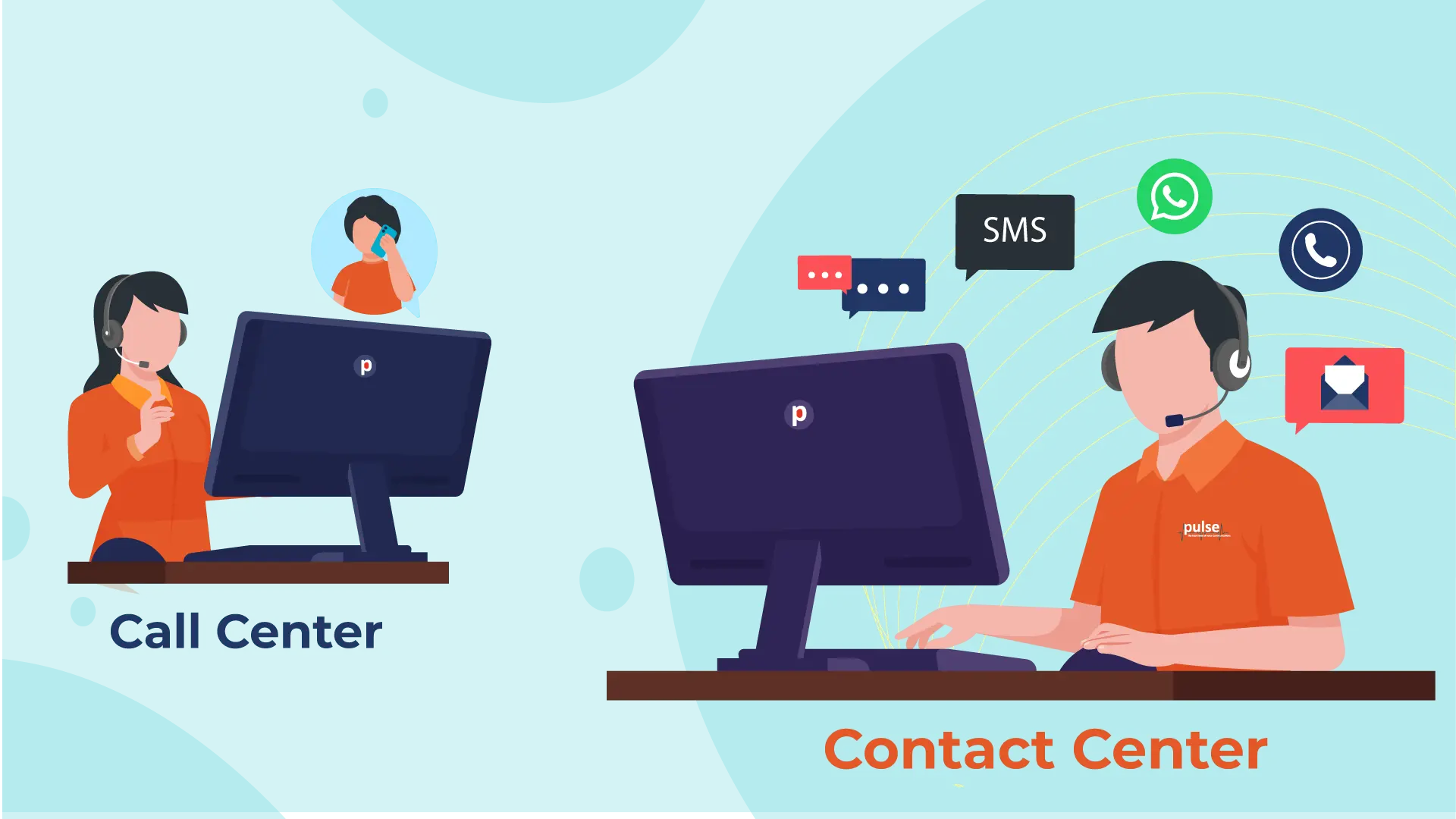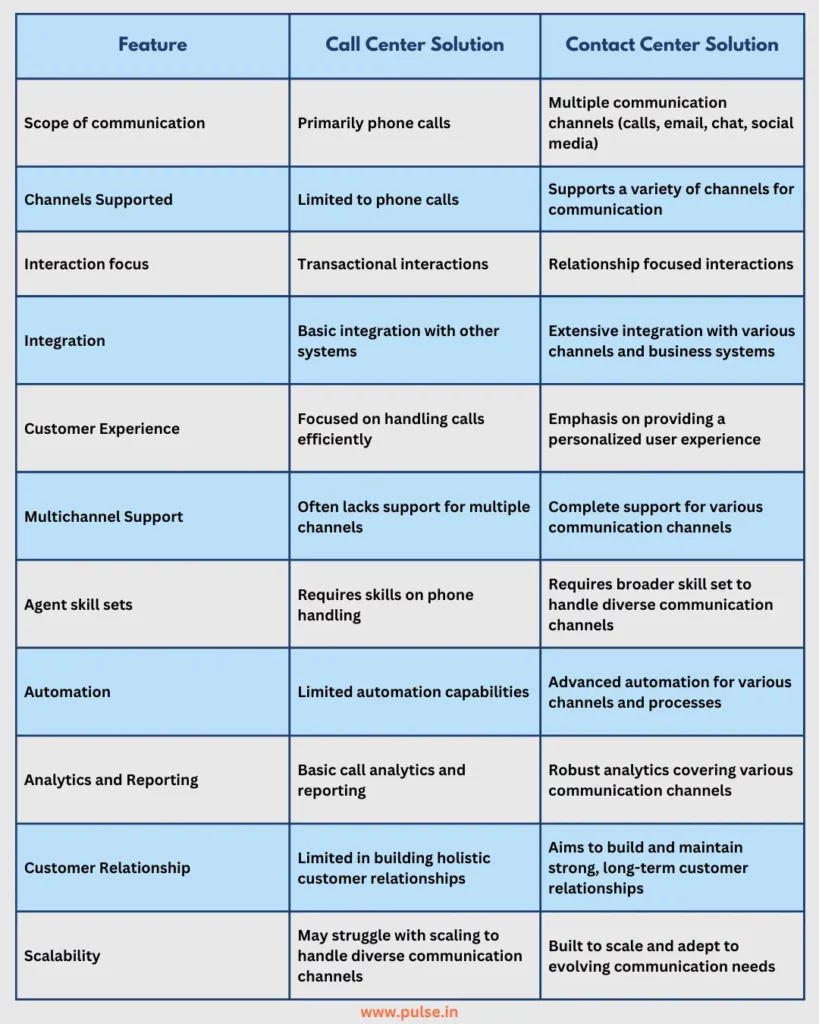
As technology continues to advance and evolve, many businesses are finding it challenging to keep up with the ever-growing technology landscape to meet changing consumer demands. With each new technology discovery, consumers become curious about trying out these innovations. "Call Center" and "Contact Center" are two common terms often used interchangeably by marketers to convince potential prospects to buy their products or services. In this blog, we will provide a complete breakdown of both the call center vs contact center, offering clarity on how to choose the ideal solution that will benefit your business in the long run.
We have all engaged in online shopping at some point in our lives. As Businesses anticipate, Customers often have inquiries that lead them to contact the business through toll-free or virtual numbers to address their concerns.
Have you ever wondered how businesses effectively manage a high volume of customer calls, ensuring minimal errors while addressing queries within a specified time frame? This is where call centers prove invaluable for businesses.
A Call Center is a dedicated department or office where trained customer service representatives handle customer concerns over the phone. Many call centers leverage specialized call center software to streamline customer interactions and ensure prompt resolution of all queries.
A Call Center can generally be divided into the following 3 types:
1.Inbound Call Center:
An Inbound Call Center is a service facility where agents/ business representatives receive incoming calls from customers or clients. Its primary focus is to address inquiries, provide support, and handle customer concerns, contributing to positive customer experiences.
Use Cases
Inbound call centers typically utilize software known as inbound call center software to enable their agents to handle all incoming customer calls with ease. Inbound call center software is a solution designed to manage and streamline all incoming customer calls within a contact center.
Technologies Incorporated:
Agents working in an inbound call center are typically familiar with key metrics including Average Handle Time (AHT), First Call Resolution (FCR), Customer Satisfaction (CSAT), Call Abandonment Rate, Occupancy Rate, Call Quality, and Agent Adherence. These KPIs are crucial for the effective functioning of an inbound call center.
2.Outbound Call Center
An Outbound Call Center is a facility where agents initiate outgoing calls to customers or prospects. Its primary focus is on activities such as telemarketing, sales calls, lead generation, market research, and customer follow-ups, aiming to proactively engage with individuals for various business purposes.
Use Cases:
Outbound call centers typically utilize outbound call center software to ensure their agents connect with the maximum number of potential prospects within a set period. Outbound call center software is a solution that facilitates and manages outgoing calls made by agents.
Technologies Incorporated
Agents in outbound call centers are generally familiar with key metrics such as Conversion Rate, Contact Rate, Call Success Rate, Average Call Duration, Lead Response Time, Agent Productivity, List Penetration, Abandonment Rate, Compliance Rate, and Cost per Contact. Adhering to and scoring positively in these KPIs ensures the success of the call center, leading to increased revenue generation.
3. Blended Call Center
A Blended Call Center is essentially a customer service facility that integrates both inbound and outbound call-handling functionalities. This flexible approach allows agents to manage incoming customer inquiries as well as initiate outgoing calls for activities such as sales, telemarketing, or proactive customer engagement, optimizing overall call center efficiency.
Use Cases:
Blended Call Centers generally utilize software known as blended call center software that empowers their agents to handle both incoming customer inquiries and outbound marketing activities.
Blended call center software is a comprehensive solution that integrates both inbound and outbound call management functionalities. It enables agents to handle incoming customer inquiries, support requests, and sales leads, while also facilitating outbound activities such as telemarketing, sales calls, and proactive customer engagement within a unified platform.
Technologies Incorporated:
Agents in blended call centers are generally familiar with both inbound and outbound metrics, while other metrics such as agent utilization, omnichannel engagement, and campaign performance are observed carefully. Ensuring adherence to these metrics presents more opportunities for the expansion of the blended call center.
We all have a situation where we would have encountered an issue be it in malfunctioning of a washing machine or an issue in a desktop. As most would do either we would try to reach the concerned department via chat or email so the concerned person assist us in the form of precise instructions when implemented help us resolve our issue.
This is where a contact center can prove to be a valuable asset to a business by assisting customers through multiple channels be it in the form of a chat, email, call or social media.
A contact center is a centralized facility/ office that manages and handles customer interactions through various channels such as phone calls, emails, and live chat. This office's sole purpose is designed to streamline business communication and provide efficient customer support for resolving their queries boosting brand engagement.
Contact Center can have a multitude of services, given below are some Contact center services examples:
Contact centers generally handle large of volumes of customer queries in the form of calls, emails, chats, SMS, social media, etc. To promptly address customer queries, these centers leverage a software known as contact center software/ contact center solutions.
A contact center solution is a technology platform that facilitates customer interactions through various channels such as phone, email, chat, and social media. It typically includes tools for customer relationship management (CRM), automatic call distribution (ACD), analytics, and other features to optimize business communication, streamline contact center operations, and improve customer support.
General Features of Contact Center Solution:
A contact center solution relies on varied technologies that aid in streamlining business processes, improving the efficiency of agents thus enhancing customer experience. Given below are a few technologies:
As we know both call center and contact solutions are used to address customer concerns in different channels, let's explore the differences between call center and contact center solutions:

As business owners, we often struggle with choosing the ideal call center vs contact center solution for our business needs. Below are a few questions you can ask yourself when facing a dilemma on selecting a call center solution or a contact center solution:
For enterprises or budding businesses, maintaining optimal customer experience is paramount for success. By carefully analyzing your business and investing in the right solutions, you can benefit in the long term. To learn how to choose your ideal solution that improves customer experience, connect with the Pulse team today. Let us assist you in selecting the best solution that meets your business needs and goes beyond.